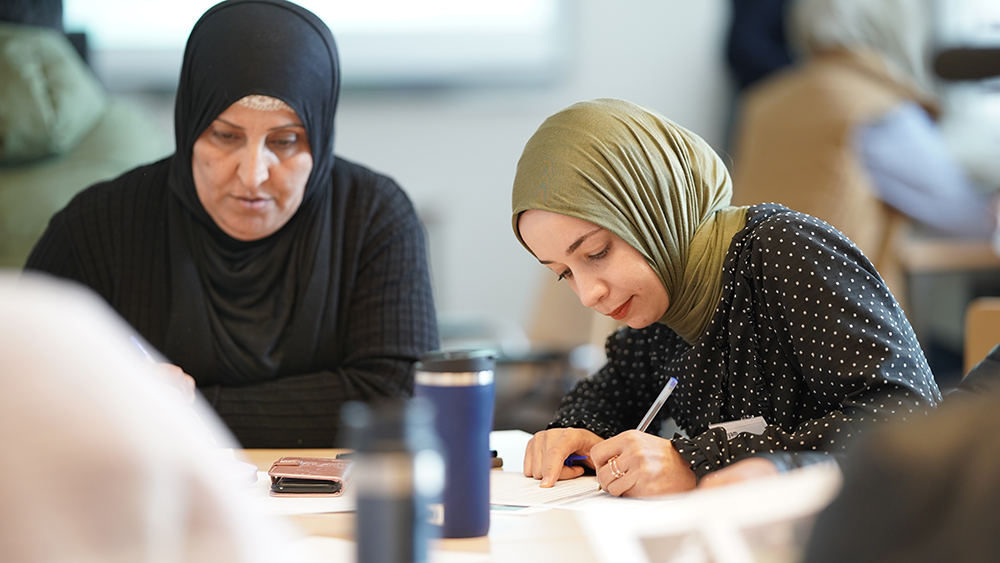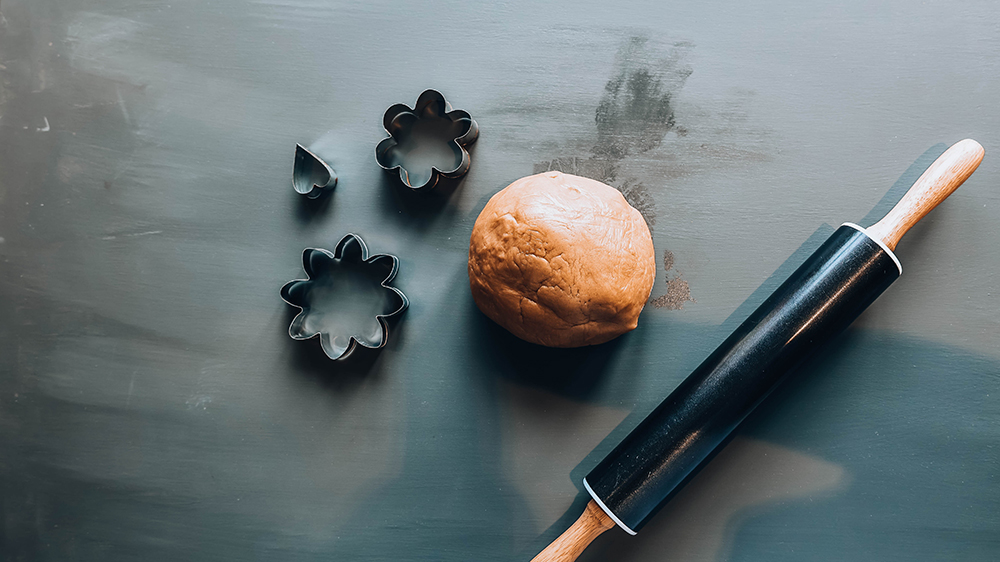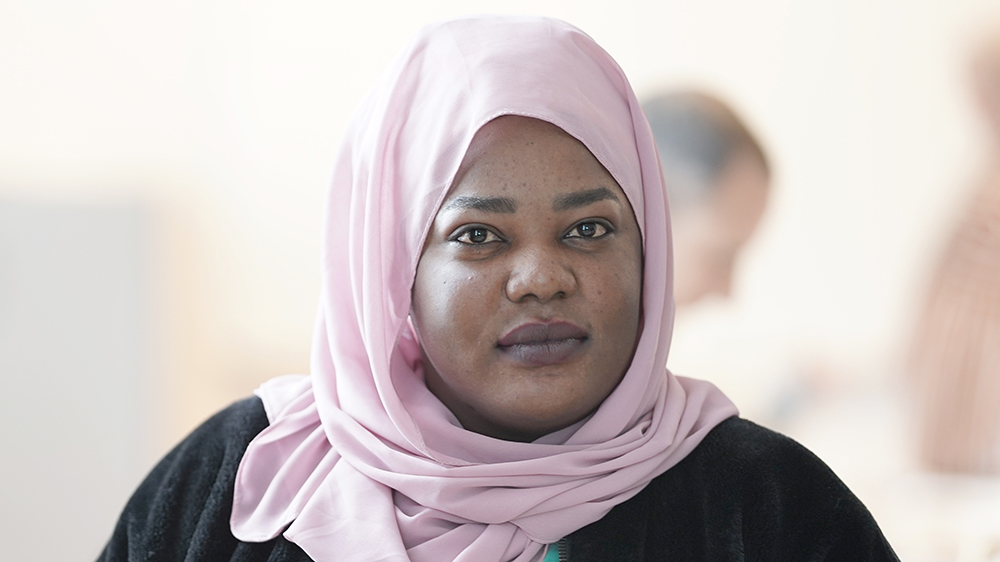My stomach started to rumble as soon as the sweet smell hit my nostrils. The spices reminiscent of wonderful Friday dinners of lamb and vegetables, followed by klecha. No matter how big or small we were, our mother always expected us to eat two, preferably three, portions for dinner. But that was a long time ago, barak ruhaha, bless her soul.
We put two new baking trays into the oven. Heart and star shapes quickly rose in the hot air. The school kitchen was redolent with the smell of gingerbread and other spices. Headmaster Fredrik had agreed to let us have our Norwegian class in the kitchen that day, even though we were receiving visitors.
“Can you make us some cinnamon tea?” I asked Amaal and Farah, two middle aged friends from Syria who came here deprived of everything before finding each other.
“Have you lost your tongue?” I asked them in Arabic.
I opened the cupboard with the nicest cups, and explained what to lose your tongue means in Norwegian and Sorani.
“How many cups do we need?” I asked.
They counted us, first in Norwegian and then in Arabic, before reaching a conclusion in Norwegian.
“Twelve,” said Farah.
“Plus one,” I said, “for the researcher.”
Amaal took another cup out of the cupboard. They continued to chat in Arabic about an experience Farah had had on the bus on the way to school. It was getting lighter outside, and the baked goods were soon ready to come out of the oven, but there was no sign of the researcher.

I wiped the last scraps of dough off the counter and turned to face the class. The room was more silent than usual, full of quiet expectation. Helin lit some candles. Sukruethai and Kannika wiped the dining table and covered it with a traditional Norwegian Christmassy tablecloth. It didn’t look right – I should have brought a simple, white one. Amaal and Farah turned their focus to laying the table, straightening the plates, correcting each other, bickering affectionately. They got Hassan to climb up onto the counter to get down the teapots that were on top of the cupboard.
Finally, there was a knock on the door. Everyone turned to watch as a tiny woman entered the warm kitchen – I think her name was Louna. She had beads of sweat on her forehead. The wisps of brown hair sticking out from underneath her hat were almost white with frost.
“Did you get my message?” she asked, out of breath, before I even managed to take her hand in greeting.
I shook my head, flashing a smile. She couldn’t have known that I always put my phone away during class.
“I’m sorry,” she said, pulling off her down jacket. “This morning turned out much busier than I expected, with two kids to get ready for St. Lucia and an unwell husband. One of my children is in kindergarten, the other in school.”
She scanned the room for something.
“Where can I set up my camera?”
“Maybe over there.”
I pointed towards the window ledge by the dining table.
The windowsill was so wide you could sit on it.
“Perfect, thank you,” she said.
It didn’t take long before the researcher had pulled a notepad, a PC and a camera from her rucksack. She tried to place the camera on a tripod with three uneven legs. It fell over. Once. Then again. Each time, Louna became more stressed.
Helin, the youngest student in the class, offered to help. I remember that she got the camera standing straight away.
“Thank you so much,” Louna said.
“You’re welcome.”
Helin didn’t look her in the eyes.
“What’s your name?” Louna asked.
“Helin,” Helin said, blushing.
The researcher checked the time and made a note of something.
Both our language assistants were at home with sick children that day, but Berit, the class teacher, was with us. With Farah in tow, she removed the last baking trays and turned off the oven. The atmosphere was tense, estranged. Visiting researchers always made me feel like I was on display. Farah looked as uncertain as I felt, restless. Berit asked her to transfer the gingerbread biscuits to a plate to keep her busy. Once again, the warm smell of nutmeg spread throughout the room.
“Amaal and Farah are making my favourite tea,” I said loudly, to drown out my stomach rumbling. “Tea is a noun, and ‘make’ is a verb, as you know,” I stated, even though I normally asked the group before giving the answer.

Berit invited us to find a seat around the dining table. While the students hesitatingly tried to decide where to sit and which chair to offer to their guest, they chatted with those they shared a language with. Everyone apart from Genet had someone to talk with. She seemed reluctant to sit beside those who were talking the loudest, and looked to me for help.
“Helin, can you make room for Genet beside you?” I asked.
She pulled out a chair, aimably.
“By the way, Helin, what’s the name of the spice you use in shai in Syria? You also use cinnamon, I know that, but what else?”
Before she had the chance to answer, Louna crept forwards and placed an audio recorder on the Christmas tablecloth between her and Genet.
“I’m just going to leave the voice recorder here. Is that OK?”
The spit-up milk stains on her red wool jumper didn't evoke maternal feelings in me like it used to.
“Maybe you’d like to introduce yourself to the class, Louna?”
She stood up and gently gazed on each of the students.
“My name is Louna Jensen,” she said, placing her hand on her chest, “and I’m here today from the University of Oslo. I’m here to observe how you are learning Norwegian.”
“Do we have to talk extra loud?” Amaal asked, her foot jiggling under the table.
Was this a sign of anxiety or suspense? Tension often rose when something new happened; when we changed subject, had new students join in the class, or a visitor, like today.
I placed my hands firmly on her shoulders.
“No, just act normally.”
“Try to forget that the voice recorder is there,” Louna said.
Her voice was gentle and yet I found the message harsh. I was suddenly struck with a feeling of out-of-placeness, seeing myself with these people so far away from their homes and the researcher so close to hers. Just a flash of time ago, Genet was still living in a village in Eritrea and Helin in Syria.
“Did you understand my question, Helin?” I asked, “about the spices you use in the shai, along with cinnamon?”
The students started chatting, some got their phones out to Google. Overhearing the Arabic-speaking group, they seemed more interested in how their voices would sound on the recording as in the spices. Amaal twisted out of my hands and pulled out her own phone. She looked at me, searchingly.
“I know what you’re thinking.”
Her phone cover sparkled and sent glittering light over the tablecloth elves. She scrolled through an app written in Arabic script.
“What am I thinking, Amaal?”
“I haven’t changed the language to Norwegian,” she said.
On the other side of the table, Louna got busy taking notes.
“My dear, you don’t have to,” I said.
Amaal looked at me, questioningly.
“Are you teasing me, habibti?”
“Not at all.”
“Inti taqila al dam,” she said with a smile, “you have thick blood”.
“We both do.”

“Do you know any other languages, apart from Arabic and Norwegian?” Louna asked.
The attention made Amaal light up even more.
“I know some Assyrian too”, she said as she finally found what she was looking for on her phone.
“Cloves,” she said, showing Louna a photo of a wooden ladle full of whole cloves, “or nellik, in Norwegian.”
“That’s right,” I said.
“Quranful,” said Amaal, showing the photo to the others.
“Do you agree, Helin?” I asked.
Helin nodded. Then, quietly, she repeated “nillik.”
“Is clove a noun or an adjective?” I asked.
“Noun,” Helin replied.
“The word clove is a noun,” I confirmed.
Suddenly, Genet grabbed on to Helin’s arm. She looked at me like she wanted to say something, her eyebrows raised. Then she looked towards Helin for help, but she didn’t speak Tigrinya either. She looked down.
“Did you want to say something, Genet?” I asked.
“I also use cloves in ...” she said, pointing at the cup Farah was holding.
“In tea?” I asked in Norwegian. “You also use cloves in tea?”
“Yes,” she replied loudly, “ቅንፍር, qnfr, in tea.”
Louna was taking notes on the conversation. Her fingers danced over the keyboard.
“Where is she from?” she asked.
“Eritrea.”
“Is there nobody here who speaks her language?”
“He’s off sick today.”
“Teacher try to help us,” Genet said to the researcher. “Teach us in Norwegian. Still difficult to understand. Like me. Berit-teacher explains in both Norwegian and English. I understand nothing. Because I go to school in Norway since September.”
Her long flow of words softened us, it was as if the table we were sitting round grew smaller.
“Your Norwegian is very good, Genet. Do you enjoy learning?” Louna asked.
“Sometimes. I get tired often. And then, I want to sleep.”
This sense of being overwhelmed by life was just how I felt when I arrived here more than 20 years ago; that it was almost impossible to learn Norwegian and break into some kind of social life. How many moments did I experience as a virtual spectator before I became fluent? Before I was able to connect with others?
“Cloves in tea,” Genet repeated.
Her smile almost reached her eyes.
Amaal slided a chair in beside Genet, pushing Helin aside.
“Norwegians don’t use cloves in their tea. They put them in oranges. Spices and oranges are expensive here.”
“You have such a big heart, Amaal,” I said, “but take it easy, OK?”
“ቅንፍር in oranges?” Genet asked, looking over to me.
Farah confirmed with an earnest face.
“Cloves in oranges that do not taste like oranges.”
Her comment made us laugh. This was something we all reacted to when we first came to Norway – how tasteless citrus fruit were, so different from the juicy, sweet fruit we could pick from the trees in our childhood gardens.
“Alright everyone, we have to taste what we’ve baked, don’t we? What would you call the biscuits we’ve just baked in your language?”
For a while, the room buzzed again with the sounds of Somali, Arabic, English, Thai and Kurdish. Genet sat looking down at her hands, waiting. After a while, the names of gingerbread biscuits could be heard in all its variety.
“بسكويت الزنجبيل”
“Lasang luyang galyeta”
“Biskêt zencebil”
“คุกกี้ขนมปังขิง”
“ባኒ ጅንጅብል”
“Buskud sanjabiil”
“بیسکویتی زەنجەفیل”
“Biskuti za tangawizi na mdalasini”

We ate, drank and chatted, while the researcher took her notes and the candles slowly melted. As things grew quieter around the table, I picked up the rest of the dough from the kitchen and held it up in front of the class.
“This is the gingerbread dough you made. The Norwegian word for gingerbread dough, peparkakedeig, is three words, three nouns that combine into one: pepar, kake and deig.”
“But there’s not a lot of pepper in a peparkake,” Ernesto said to me, giggling.
“True, it is more like a spice biscuit. But how did we make the dough flat?”
Deeqo and Samatar spoke quietly with each other in Somali, and I let them. Outside, it had started to snow, light snowflakes falling closely to the ground. The camera on the windowsill kept filming.
I tried to get eye contact with Genet, but she kept her eyes on her lap or her hands. Her necklace, a cross, transported me back home to the garden in Iraq, to my precious orange tree, my mother sitting in the shade of the tree, barak ruhaha, the necklace around my mother’s neck. Today would have been her birthday, but ommi died the year after I left, one month before I was ready to bring her over to the new world.
“Deeqo,” I said, after a while. “What is the name for rolling pin in Somali?”
“Fidin,” she replied.
“In Norwegian, is rolling pin, or kjevle, a noun or a verb?” I asked.
“Both,” Deeqo replied. “A kjevle and to kjevle.”
The researcher looked up from her computer screen, impressed. I just smiled.
“How about apron, do you know what that is?” I asked the class.
Kannika used her body to show us what an apron was.
“And who wears one?” I asked.
Louna stopped taking notes, closed the screen on her computer, and looked from student to student. The room fell quiet. All we could hear was the fan in the oven.
After a while, Sukruethai looked up from her notebook where she wrote down every new word in English, Thai and Norwegian.
“Women wear aprons, women who cook food,” she said.
Berit and I exchanged glances. No one objected.
“I wish women would wear aprons more often,” Hassan said with a laugh.
Like me, he had found a Norwegian partner and had to take responsibility for filling his new kitchen with the flavours and smells he most enjoyed. His joke brought the quiet-mannered Helin to life.
“My brother wears an apron. Baba wears an apron. Baba slaughters animals,” she said, and showed with her hands how while repeating the two words, slaughter and animals.
Her gesture evoked an image from the day I left Iraq, of the chaos, the screams, the tiny girl with blood stains in her plaited hair. “My name’s Amina,” she screamed, as I ran past her over the square by the railway station, with the thunderous sound of the bombs behind us. I can still see the square, feel the terror of that day, down to the tiniest of details.
I looked at Helin and forced a smile while raising my hand to get her to stop.
She didn’t.
“The chefs in the restaurants are often men, both in Syria and in Norway, and they wear aprons. First, the men slaughter the animals, with aprons on. Then other men with aprons on cook their bodies,” she said, as I felt my head become lighter.
My head felt so light it was almost as if it came free from my neck and rose upwards, all the way up, until any smell of spices disappeared.
About the text
The project Multilingual strategies and resources in the education of adult immigrants is funded by Kompetanse Norge (2020–2021). The researchers are Joke Dewilde (University of Oslo, project manager) and Ingrid Rodrick Beiler (OsloMet – Oslo Metropolitan University).
For our research, we collaborated with five teachers at an adult education centre to explore multilingualism as a resource in teaching adult immigrants with little documented schooling. We collaborated with teachers to develop, implement and evaluate lessons that drew on students’ multilingualism through six workshops over the course of one year.
The short story is based on ethnographic observations made by Ingrid and Joke in one of the classes. The participants came from Afghanistan, Eritrea, the Philippines, DR Congo, Thailand, Somalia, and Syria. One of the teachers had fled Iraq and come to Norway ten years earlier, and she used her own experiences and multilingual resources when teaching. We observed her and her class on several occasions and made both video and audio recordings. We also interviewed the teacher and several of the participants in the class. The main character of the short story is based on this teacher, but biographical details and teaching practices have been rewritten to some extent.
The short story represents discussions and practices found in the classroom. The plot follows the teacher and fictional participants during lessons. The short story is not a direct reproduction of research data, but rather Monica Bjermeland’s reproduction of field notes, transcripts based on video and audio recordings and conversations. It represents both ethnographic fiction and creative non-fiction.
The short story is particularly suitable for people studying or practicing multilingualism as a form of teaching.
